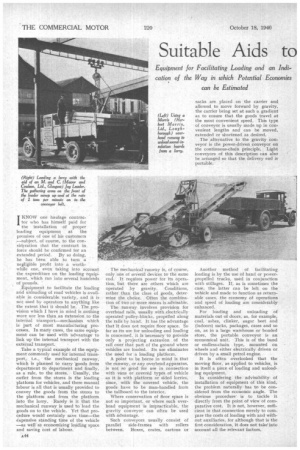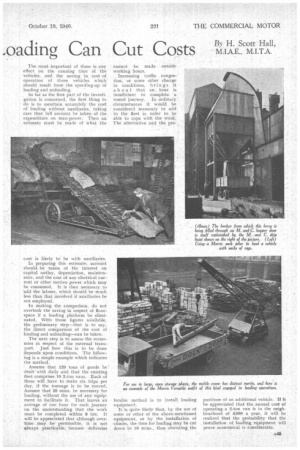Suitable Aids to ,oading Can Cut Costs By H. Scott Hall,
Page 78

Page 79

If you've noticed an error in this article please click here to report it so we can fix it.
Equipment for Facilitating Loading and an Indi. cation of the Way in which Potential Economies can be Estimated
IKNOW one haulage contractor who has himself paid for the installation of proper loading equipment at the premises of one of his customers
.—subject, of course, to the consideration that the contract in force should be confirmed for an extended period. I3y so doing, . he has been able to turn a negligible profit into a worth while one, even taking into account the expenditure on the loading equipment, Which ran into several hundreds of pounds. • Equipment to facilitate the loading arid Unloading of road vehicles is available in considerable variety, and it is not used by operators to anything like the extent that it should be. The. provision which I have in mind is nothing more nor less than an extension to the internal transpOrt—mechanism which ia part of most manufacturing processes. In many cases, the same equipment can be used with advantage to link up the internal transport with the external transport. Take a typical example of the equipment commonly used for internal transport,. i.e., the mechanical • runway, which is planned to carry 'goods from department to department and finally, as a rule, to the stores. Usually, the outlet from the stores is the loading platform for vehicles, and there manual labour is all that is usually provided to convey the goods from the stores to the platform and from the platform into the lorry. Rarely is it that the mechanical runway is used to load the goods on to the vehicle. Yet that procedure would certainly save time—the expensive standing time of the vehicle —as well as economizing loading space and saving cost of labour. The mechanicarrunway is, of course, only one of several devices to the same end. It requires power for its operation, but there are others which are operated by gravity. Conditions, rather than the class of goods, determine the choice. Often the combination of two or more means is advisable.
The runway involves provision for overhead rails, usually with electrically operated pulley-blocks, propelled along the rails by hand. It has the advantage that it does not require floor space. So far as its use for unloading and loading is concerned, it is "necessary to provide only a projecting extension of the rail over that part of the ground where vehicles are loaded. Its use eliminates the need for a loading platform.
A point to be borne in mind is that the runway, or any overhead apparatus, is not so good for use in connection with vans or covered types of vehicle as it is with platform or sided lorries, since, with the covered vehicle, the goods have to be man-handled from the tailboard to the interior.
Where conservation of floor space is not so important, or where such overhead equipment is inipracticable, the gravity conveyor can often be used with advantage.
Such conveyors usually consist of parallel side-frames with rollers between. Boxes, crates, cartons Cr sacks are placed on the carrier and allowed to move forward by gravity, the carrier being set at such a gradient as to ensure that the goods travel at the most convenient speed, This type of conveyor is usually made up in convenient lengths and can be moved, extended or shortened as desired.
The alternative to the gravity conveyor is the power-driven conveyor on the continuous-chain pr-inciple. Light conveyors of this description can also be arranged so that the delivery end is portable.
Another method of facilitating loading is by the use of hand or power propelledtrucks, used in conjunction with stillages. If, as is sometimes the case, the latter can be left on the vehicle and made to function as returnable cases, the economy of operations and speed of loading are considerably enhanced.
For loading and unloading of materials out of doors, as, for example, coal, ashes, clinker, sugar beet and (indoors) sacks, packageS, cases and so on, as in a large warehouse or bonded store, the portable conveyor is an economical unit. This is of the band or endless-chain type, mounted on wheels and either electrically driven or driven by a small petrol engine.
It is often overlooked that the moving floor, as applied to vehicles, is in itself a piece of loading and unloading equipment.
In considering the advisability, of installation of equipment of this kind, the problem naturally has to be considered from the economic angle. The obvious procedure is to tackle it directly from the point of view of comparative cost. It is not, however, sufficient in that connection merely to compare the costs of loading with and without auxiliaries, for although that is the first consideration, it does not take' into account all the relevant factors_
The most important of these is any effect on the running time of the vehicles, and the saving in cost of operation of those vehicles which. should result from the speeding-up of
loading and unloading. •
So far as the first part-of the investigation is concerned, the first thing to do is to ascertain accurately the cost of loading without auxiliaries, taking care that full account be taken of the expenditure on man-power. Then an estimate must be made of what the
cost is likely to he with auxiliaries.
In preparing this estimate, account should-. be taken of the interest on capital outlay, depreciation, maintenance, and the cost of any electrical current or other motive power which may be consumed. It is then necessary to 'add the labour, which should be muc,h less than that involved if auxiliaries be not employed. .
In making the comparison, do not overlook the saving in respect of floorspace if a loading platform be eliminated, With those figures available, the preliminary step—that is to say, the direct comparison of the cost of loading and unloading—can be taken.
The next step is to assess.the economies in respect of the external transport. Just how this is to be done depends upon conditions. The following is a simple example which indicates the method.
Assume that 120 tons of goods be -dealt with daily and that the existing fleet comprises 10 2-ton vans. Each of these will have to make six trips per day, if the tonnage is to be moved. Assume that 20 mins. be necessary for loading, without the use of any equipment to facilitate it. That leaves an average of one hour for each journey on the understanding that the work must be completed within -8 hrs. It will be appreciated that although overtime may be permissible, it is not always practicable, because deliveries
cannot be made outside working hours.
Increasing traffic congestion, or some other change in conditions, brings it about that an. hour is insufficient to complete a round journey. In ordinary circumstances it would be considered necessary to add to the fleet in order to be . able to cope with the work.. The alternative and the pre
ferable method is to install loading equipment.
It is quite likely that, by the use of some or other of the above-mentioned equipment, or by the installation of chutes, the time for-loading may be cut down to. 10 mins„ thus obviating the
purchase of an additional vehicle. If it be appreciated that the annual cost of operating a 2-ton van is in the neighbourhood of £500 a year, it will be realized that the probability that the installation of loading, equipment Will prove economical is considerable.




































































































